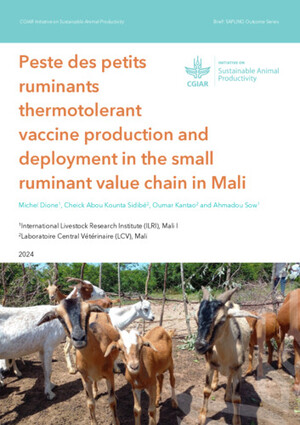
Evaluation of non-conventional agro-industrial by-products as supplementary feeds for ruminants: In vitro and metabolism study with sheep
Abstract
In vitro and in vivo evaluation of non-conventional feed resources was carried out in the International Livestock Research Institute (ILRI), Debre Zeit Station, Ethiopia, using shee10 non-conventional feed types commonly used by urban and peri-urban livestock farmers were obtained from the farming system and evaluated in vitro following standard procedures. Following in vitro studies, five non-conventional feed types were selected for in vivo studies based on the in vitro result, availability, and wide use by farmers. 30 indigenous rams weighing 22.6 +- 0.97 (mean +- SD) kg initially were stratified into weight groups and assigned randomly to treatments. Treatments included Tela atella (traditional brewery residue), Katicala atella (traditional liquor residue), lentil (Lens culinaris) hull, rough pea (Lathyrus sativa) hull, and field peas (Pisum sativum) hull based on the basal diet of native grass hay (control). In vitro study indicated that Tela and K. atella had higher organic matter (97-98%), crude protein (CP) (21%), and gross energy (GE) (21-22 MJ/kg DM), and lower fibre fractions (neutral detergent fibre, NDF=41-60%; acid detergent fibre, ADF=11-21%). Pulse hulls (lentil, rough pea, and field pea hulls) had medium to high CP (8-16%), lower GE (17-19.5 MJ/kg DM), and higher fibre fractions (NDF=49-71%; ADF=49-62%). Among the pulse hulls considered, lentil hull had the highest CP (16%), and lowest NDF (49.4%) and ADF (48.6%). Poultry litter and orange peel had the highest CP (30%) and GE (28 MJ/kg DM), respectively. Results of the in vivo study indicated that both T. atella and K. atella and pulse hulls improved total dry matter, organic matter, nitrogen, energy, and NDF intakes. The improvement was higher for T. atella and K. atella compared to pulse hull groups. Basal diet intake was reduced when pulse hulls were fed. T. atella, K. atella, and lentil hull had higher nitrogen and energy digestibility compared to pulse hulls and the control. Supplementation improved nitrogen retention, with T. atella, K. atella, and lentil hull. Therefore, given the increasing competition with monogastric animals and increasing price of conventional byproducts coupled with the deteriorating quality of tropical forages, T. atella, K. atella, and lentil hull have potentials to be used as a protein and energy (except lentil hull) supplements on low quality based diet under small holder livestock production systems. Further research is warranted to lower the concentration of tannins and fibre in pulse hulls and improve the feeding system to enhance the utilization of T. atella and K. atella.
Citation
Small Ruminant Research;44(1): 25-35










